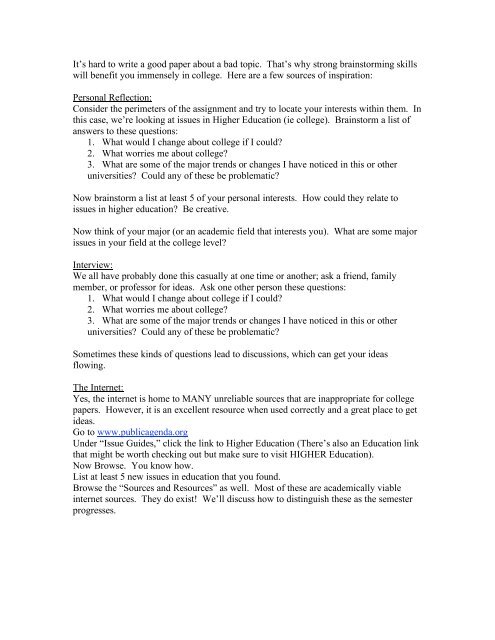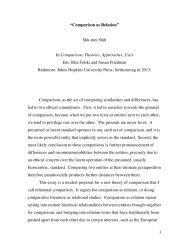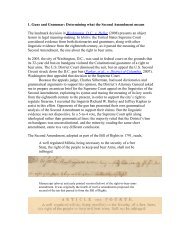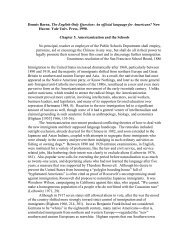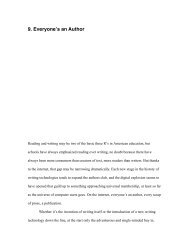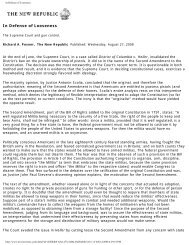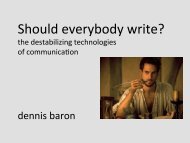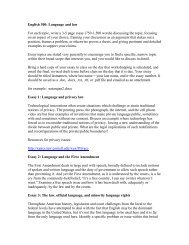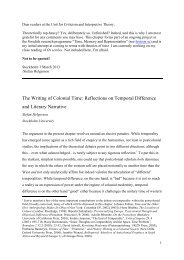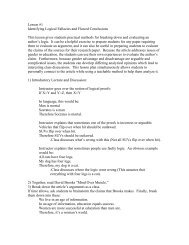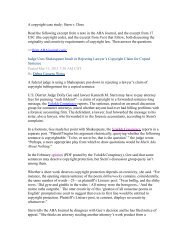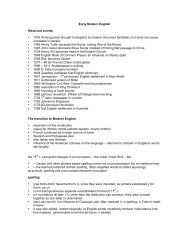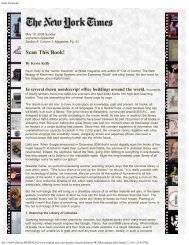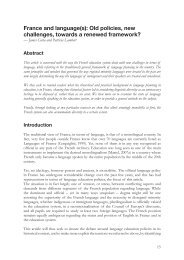It's hard to write a good paper about a bad topic. That's why ... - English
It's hard to write a good paper about a bad topic. That's why ... - English
It's hard to write a good paper about a bad topic. That's why ... - English
You also want an ePaper? Increase the reach of your titles
YUMPU automatically turns print PDFs into web optimized ePapers that Google loves.
It’s <strong>hard</strong> <strong>to</strong> <strong>write</strong> a <strong>good</strong> <strong>paper</strong> <strong>about</strong> a <strong>bad</strong> <strong>to</strong>pic. That’s <strong>why</strong> strong brains<strong>to</strong>rming skills<br />
will benefit you immensely in college. Here are a few sources of inspiration:<br />
Personal Reflection:<br />
Consider the perimeters of the assignment and try <strong>to</strong> locate your interests within them. In<br />
this case, we’re looking at issues in Higher Education (ie college). Brains<strong>to</strong>rm a list of<br />
answers <strong>to</strong> these questions:<br />
1. What would I change <strong>about</strong> college if I could?<br />
2. What worries me <strong>about</strong> college?<br />
3. What are some of the major trends or changes I have noticed in this or other<br />
universities? Could any of these be problematic?<br />
Now brains<strong>to</strong>rm a list at least 5 of your personal interests. How could they relate <strong>to</strong><br />
issues in higher education? Be creative.<br />
Now think of your major (or an academic field that interests you). What are some major<br />
issues in your field at the college level?<br />
Interview:<br />
We all have probably done this casually at one time or another; ask a friend, family<br />
member, or professor for ideas. Ask one other person these questions:<br />
1. What would I change <strong>about</strong> college if I could?<br />
2. What worries me <strong>about</strong> college?<br />
3. What are some of the major trends or changes I have noticed in this or other<br />
universities? Could any of these be problematic?<br />
Sometimes these kinds of questions lead <strong>to</strong> discussions, which can get your ideas<br />
flowing.<br />
The Internet:<br />
Yes, the internet is home <strong>to</strong> MANY unreliable sources that are inappropriate for college<br />
<strong>paper</strong>s. However, it is an excellent resource when used correctly and a great place <strong>to</strong> get<br />
ideas.<br />
Go <strong>to</strong> www.publicagenda.org<br />
Under “Issue Guides,” click the link <strong>to</strong> Higher Education (There’s also an Education link<br />
that might be worth checking out but make sure <strong>to</strong> visit HIGHER Education).<br />
Now Browse. You know how.<br />
List at least 5 new issues in education that you found.<br />
Browse the “Sources and Resources” as well. Most of these are academically viable<br />
internet sources. They do exist! We’ll discuss how <strong>to</strong> distinguish these as the semester<br />
progresses.
Annotated Bibliography Script Rhe<strong>to</strong>ric 105<br />
Rationale:<br />
You should think of using sources by putting them in<strong>to</strong> conversation with each other and<br />
finding your own role in that conversation. This assignment asks you <strong>to</strong> take that<br />
“conversation” metaphor seriously.<br />
Assignment:<br />
Using at least 5 of your 8 sources, create a 2-3 page script of a conversation among the<br />
sources and yourself. That is, <strong>write</strong> a script of the conversation that might take place if<br />
you and all the authors of your sources could be <strong>to</strong>gether in the same room at the same<br />
time. You can <strong>write</strong> whatever you want for your own contributions, but the contributions<br />
from your sources should consist of either direct quotations or paraphrases, which should<br />
be cited parenthetically.<br />
Notes on the Script:<br />
- Be creative. While the default format is a dramatic script (that is, written like<br />
a play), you may choose <strong>to</strong> represent this conversation in any way you like.<br />
- Start by providing a “cast of characters,” a list of participants in this<br />
conversation.<br />
- Briefly describe the imaginary setting for this conversation.<br />
- The majority of the script should be direct quotations from your sources.<br />
- Put quotation marks around everything you are taking directly from a source,<br />
and put the author’s last name and the page number for that quote in<br />
parentheses. If you need <strong>to</strong> add anything <strong>to</strong> the quotes <strong>to</strong> make them “flow”<br />
better, put that stuff in brackets [like this].<br />
- Don’t just make a list of random quotes from sources. Rather, make the<br />
sources “speak or respond <strong>to</strong> each other, or make them respond <strong>to</strong> questions<br />
you might pose <strong>to</strong> them.<br />
- Also, don’t limit yourself <strong>to</strong> presenting quotes from sources that agree with<br />
you. Try <strong>to</strong> represent the range of possible positions concerning your <strong>to</strong>pic.<br />
- Make yourself a character or participant in this conversation. You might<br />
choose <strong>to</strong> mostly ask questions of your sources, or you might take a position<br />
of your own.<br />
- In addition <strong>to</strong> your sources and yourself, you may include “fictional”<br />
composite characters that represent a particular position or way of looking at<br />
your issue. Don’t overuse this function.<br />
Criteria of Evaluation:<br />
- The degree <strong>to</strong> which this collage puts your sources in<strong>to</strong> a genuine<br />
conversation with each other, rather than simply listing quotations from these<br />
sources.<br />
- The degree <strong>to</strong> which you fairly represent a range of possible positions or<br />
points of view on your <strong>to</strong>pic.<br />
- The correctness of the in-text citations (see the Wadsworth Handbook)<br />
Due Date: Monday 4/3
Paragraphing with Sources Rhe<strong>to</strong>ric 105<br />
Read the following and consider how they might best be arranged, along with your own<br />
sentence-combining and transitional phrases. Write the best paragraph you can on a sheet<br />
of note <strong>paper</strong>. Things <strong>to</strong> consider: Which of the statements below makes the best <strong>to</strong>pic<br />
sentence? What sequence seems most logical? How are ideas best connected <strong>to</strong> one<br />
another with transitional phrases? What signal phrases are most appropriate <strong>to</strong> introduce<br />
the given quotes and paraphrases?<br />
1. The majority of jobs given <strong>to</strong> people from poor backgrounds as well as the jobs<br />
given <strong>to</strong> minorities are ones that offer no opportunities for influencing the system.<br />
2. The health care system <strong>to</strong>day perpetuates the racist and sexist stereotypes that<br />
exist in society.<br />
3. “Women of color, immigrant women and poor women, as well as lesbians are at a<br />
significant disadvantage as long as the delivery system is controlled by<br />
individuals whose backgrounds are so different from [theirs]” (Sherwin 232).<br />
4. By keeping the oppressed out of health care, the health care system keeps these<br />
people from being healthy, and thus keeps them from having the same chances as<br />
affluent whites.<br />
5. Most doc<strong>to</strong>rs and hospital administra<strong>to</strong>rs are white males, and most nurses are<br />
white females (Humana par. 11).<br />
6. Women and minorities have no real voice in the health care system.<br />
7. The health care system does not merely mirror the power and privilege structures<br />
of the larger society; it maintains them (Sherwin 228).
Texts In Conversation Rhe<strong>to</strong>ric 105<br />
Note: Keep in mind that your aim in this exercise is not <strong>to</strong> arrive at your opinion of the<br />
sources, but <strong>to</strong> construct the conversation that you think the author of one might have<br />
with the author of another. How might the author of number 1 recast the ideas of the<br />
author’s of either number 2 or 3?<br />
* * *<br />
1) If I <strong>write</strong> “The his<strong>to</strong>ry of the United States begins with the Mayflower,” a<br />
statement many readers may find simplistic and controversial, there will be little doubt<br />
that I am suggesting that the first significant event in the process that eventuated in what<br />
we now call the United States is the land of the Mayflower. Consider now a sentence<br />
grammatically identical <strong>to</strong> the proceeding one and perhaps as controversial: “The his<strong>to</strong>ry<br />
of the United States is a his<strong>to</strong>ry of migration.” The reader may choose <strong>to</strong> understand both<br />
uses of the word his<strong>to</strong>ry as emphasizing a sociohis<strong>to</strong>rical process. Then, the sentence<br />
seems <strong>to</strong> suggest that the fact of migration is the central element in the evolution of the<br />
United States. But an equally valid interpretation of that sentence is that the best<br />
narrative <strong>about</strong> the United States is a s<strong>to</strong>ry of migration. That interpretation becomes<br />
privileged if I add a few qualifiers: “The true his<strong>to</strong>ry of the United States is a his<strong>to</strong>ry of<br />
migrations. That his<strong>to</strong>ry remains <strong>to</strong> be written.”<br />
2) The literature on slavery in the Americas and on the Holocaust suggests that there<br />
may be structural similarities in global silences, or at the very least, that erasure and<br />
banalization are not unique <strong>to</strong> the Haitian Revolution. At the level of generalities, some<br />
narratives cancel what happened through direct erasure of facts or their relevance. “It”<br />
did not really happen; it was not that <strong>bad</strong>, or that important. Frontal challenges <strong>to</strong> the fact<br />
of the Holocaust or <strong>to</strong> the relevance of Afro-American slavery belong <strong>to</strong> this type: The<br />
Germans did not really build gas chambers; slavery also happened <strong>to</strong> non-blacks.<br />
3) I prefer <strong>to</strong> say that Columbus “stumbled on the Bahamas,” or “discovered the<br />
Antilles,” and I prefer “conquest” over “discovery” <strong>to</strong> describe what happened after the<br />
landing. Such phrasings are awkward and may raise some eyebrows. They may even<br />
annoy some readers. But both the awkwardness and the fact that the entire issue can be<br />
dismissed as trivial quibbling suggests that it is not easy <strong>to</strong> subvert the very language<br />
describing the facts of the matter. For the power <strong>to</strong> decide what is trivial—and<br />
annoying—is also part of the power <strong>to</strong> decide how “what happened” becomes “that<br />
which is said <strong>to</strong> have happened.”
Paragraph Glossing Rhe<strong>to</strong>ric 105<br />
Paragraph glossing is a method of evaluating and revising your writing at the level of the<br />
paragraph. Following the steps listed below should help you determine if your essay is<br />
structurally coherent, if your argument proceeds logically, if it is repetitive, and if your<br />
paragraphs are in the right order.<br />
Step 1: Number each of the paragraphs in your <strong>paper</strong>, e.g. 1, 2, 3…<br />
Step 2: On a separate piece of <strong>paper</strong>, <strong>write</strong> a gloss (a one sentence summary) of each<br />
paragraph, leaving 3-4 lines after each one numbering them just as you did on the <strong>paper</strong>.<br />
Your gloss can be your <strong>to</strong>pic sentence if that works best.<br />
Step 3: Set your essay aside, and read through your glosses in the order you have written<br />
them.<br />
Step 4: Ask yourself these questions <strong>about</strong> each of your glosses, then make notes where<br />
appropriate:<br />
A. Immediately after each gloss, state its relationship <strong>to</strong> the previous gloss.<br />
B. Do the glosses seem <strong>to</strong> proceed logically? Identify those that seem out of<br />
place.<br />
C. Do any of the glosses repeat <strong>to</strong>pics already covered? Identify those that do<br />
and consider either deleting the associated paragraph or combining paragraphs<br />
on the same subject.<br />
D. If the gloss does not appear as written in its associated paragraph, would it<br />
work as a <strong>to</strong>pic sentence?<br />
Step 5: Identify those glosses/paragraphs whose order troubles you. Try reading the<br />
glosses in different order, e.g. 1, 2, 3, 5, 4, 6, 9, 7, 8…. Does anything change? If the<br />
order doesn’t seem <strong>to</strong> matter, then your essay probably needs a controlling purpose or<br />
idea that will give it momentum or direction.
(Note: This assignment can be used either when the instruc<strong>to</strong>r reserves the Cites computer lab in the<br />
Undergraduate Library or in any other computer classroom. This assignment will not take an entire class<br />
period; the rest of the period, then, can be devoted <strong>to</strong> individual research.)<br />
Undergraduate Library Research Worksheet Rhe<strong>to</strong>ric 105<br />
1). What are the differences between EBSCO and LexisNexis? What sorts of sources<br />
does each specialize in providing?<br />
2). At this point, what are the key terms guiding your research? What is the <strong>to</strong>pic<br />
and what ideas/concepts regarding this <strong>to</strong>pic do you plan <strong>to</strong> explore? Try <strong>to</strong> come<br />
up with at least three key terms.<br />
3). For each of these key terms, come up with at least five synonymous or related<br />
keywords you might use <strong>to</strong> expand your searches in online databases and catalogs.<br />
4). Find at least one web resource that pertains <strong>to</strong> your <strong>to</strong>pic that would not be an<br />
appropriate or reliable source for your <strong>paper</strong>. List the name of the site, where it’s<br />
found, and explain <strong>why</strong> you believe it wouldn’t work.<br />
5). Locate at least one pertinent scholarly article via the online databases, skim it,<br />
and explain—based on this quick look—how you think it might contribute <strong>to</strong> your<br />
argument. Be sure <strong>to</strong> <strong>write</strong> down what database you found it in and what<br />
publication it appears in.
Evaluating Electronic Sources Rhe<strong>to</strong>ric 105<br />
For our next class:<br />
Find three online sources that you find credible and three that are not-so-credible.<br />
Be sure <strong>to</strong> print them out and bring them <strong>to</strong> class. In the margins note what makes<br />
each source credible or not.<br />
Then, in class:<br />
In small groups, develop a list of qualities that the credible sources share and the<br />
less credible sources share.
(This in-class assignment can be used for individual work, group work, or whole-class discussion. The<br />
point is <strong>to</strong> present students with sample passages that have a variety of errors that they can attempt <strong>to</strong><br />
correct. This not only emphasizes documentation techniques, but offers students a chance <strong>to</strong> become even<br />
more comfortable using the guide <strong>to</strong> troubleshoot.)<br />
Rules for Writers Worksheet Rhe<strong>to</strong>ric 105<br />
1) In “The Crown,” a 1915 metafictional essay that complements the philosophies<br />
explored in Women in Love, Lawrence <strong>write</strong>s, “He who triumphs, wins.” (262).<br />
2) As John King Fairbank and Merle Goldman rightly claim, the “rigid mold”<br />
established by Hongwu at the onset of the Ming era left “the Ming<br />
administration…eventually unable <strong>to</strong> adjust…<strong>to</strong> China’s changing needs”<br />
(Fairbank and Goldman 133).<br />
3) Discussing the development of America’s middle class, Stewart Ewen offers a<br />
corollary that can help us clarify the nature of liberal education, he claims that as<br />
the American middle-class developed the production of lower-quality replicas of<br />
high-quality <strong>good</strong>s comprised the formation of new “cultural wages” (191).<br />
4) Laurence Pringle notes that the hatcheries in which female chickens are housed<br />
while they produce eggs leave only enough room for each chicken <strong>to</strong> eat, drink,<br />
defecate, and lay eggs.<br />
5) In The Weak King Dilemma in the Shakespearean His<strong>to</strong>ry Play, critic Manheim<br />
<strong>write</strong>s, “The incompatibility between man and job appears most clearly and<br />
emphatically in Ric<strong>hard</strong> II” (57).<br />
6) In 1928, Hines and Armstrong collaborated on revolutionary recordings that,<br />
“have had a lasting influence on jazz piano” (Pareles 32).<br />
7) Although the <strong>to</strong>wn and the country are often pitted against each other in literary<br />
and artistic representations, Mr. Williams notes with irony that “directly or<br />
indirectly most <strong>to</strong>wns seem <strong>to</strong> have developed as an aspect of the agricultural<br />
order itself” (48).<br />
8) The novel “News From Nowhere” exhibits William Morris’ own<br />
conceptualization of u<strong>to</strong>pia.<br />
9) Since the Middle Ages Norwich has been among the most important cities in<br />
England; in fact, until the early-eighteenth century, Norwich was England’s<br />
second largest city, surpassed only by London (Daiches, Flower 172).<br />
10) Rather than encouraging his readers <strong>to</strong> improve society, Emerson dismisses<br />
society as a hopeless concept. In “Self-Reliance” he <strong>write</strong>s,<br />
“Society never advances. It recedes as fast as one side as it gains on the<br />
other. It under undergoes continual change: it is barbarous, it is civilized, it
(Rules for Writers Worksheet cont.)<br />
is christianized, it is rich, it is scientific; but this change is not<br />
amelioration. For every thing that is given, something is taken. Society<br />
acquires new arts and loses old instincts” (1556).<br />
Society offers no opportunity for true human improvement, because it continually<br />
and arbitrarily exchanges one thing for another, controls and surrenders impulses<br />
in favor of religious, or political, or social doctrines that deem our instincts<br />
wrong.<br />
11) In a discussion <strong>about</strong> the Australian poets of the 1890s, critic G.A. Wilkes wrote<br />
that “their work was aimed always at the meridian of popular taste: they wrote<br />
the sort of literature that did not need <strong>to</strong> be interpreted before it could be<br />
unders<strong>to</strong>od,” (33).<br />
12) The following passage from Robert Baden Powell’s 1908 Scouting for Boys<br />
illuminates a significant cultural call for men <strong>to</strong> return <strong>to</strong> the masculinity of the<br />
imperial Vic<strong>to</strong>rian age:<br />
The “trappers” of North America, hunters of Central Africa, the British<br />
pioneers, explorers, and missionaries over Asia and all the wild parts of the<br />
world, the bushmen and drovers of Australia, the constabulary of North-<br />
West Canada and South Africa—all are peace scouts, real men in every<br />
sense of the word…they…are strong and plucky, ready <strong>to</strong> face any danger<br />
and always keen <strong>to</strong> help each other. They are accus<strong>to</strong>med <strong>to</strong> take their lives<br />
in their hands, and fling them down without hesitation if they can help their<br />
country doing so (qtd. in Blakely 192).<br />
13) In the movie “Saving Private Ryan” a brand of war-related realism is brought <strong>to</strong><br />
the screen.<br />
14) Essentially, both Love on the Dole and The Aerodrome implicitly argue for the<br />
need for Ideological balance in the struggle for societal progression.<br />
15) As R.W. Sharples notes on page 123, “the ultimate motivation for virtuous<br />
behavior in S<strong>to</strong>icism is concern for one’s own virtues.”<br />
16) According <strong>to</strong> Samuel Sillen, Orwell concedes that humans are deplete of any<br />
decency which they once possessed. And are doomed <strong>to</strong> self-incurred destruction<br />
(276).<br />
17) As M.H. Abrams explained, gender does not denote the specific, physical traits<br />
of a sex; instead, it addresses the attributes bes<strong>to</strong>wed upon a sex by society, as<br />
well as the determinate aspects that members of the same sex adopt (235).<br />
18) In his New York Times edi<strong>to</strong>rial, Nicholas Kris<strong>to</strong>f argues that America’s<br />
freedom of press is being stymied by the limitations on information exchange put<br />
in place by the Bush Administration.
Avoiding Plagiarism Rhe<strong>to</strong>ric 105<br />
Incorporating and Attributing Your Sources<br />
Write a new paragraph that corrects the plagiarism in the samples. In your correction, be<br />
sure <strong>to</strong> make attributions—identify the author and smooth the “seams” between your<br />
source’s ideas and your writing. Add in-text and parenthetical citations when needed.<br />
Source: John Culhane, The American Circus, p. 305<br />
At the Cirque Napoleon in Paris in 1859, Jules Leotard presented the first flying trapeze<br />
act. A contemporary account marveled at Leotard’s “reckless breakneck flights from<br />
trapeze <strong>to</strong> trapeze like some tropical bird swooping from branch <strong>to</strong> branch.” In case he<br />
fell, a padded mattress was spread the whole length of the stage. Eventually, the mattress<br />
was replaced by a net…the old-fashioned rope net is the form of protections still used in<br />
the circus. “The net itself can be very dangerous,” said Ti<strong>to</strong> Gaona (a trapeze artist), “but<br />
it’s a circus tradition. Our fans love <strong>to</strong> see us bounce from the net.”<br />
Paraphrased: According <strong>to</strong> John Culhane, the first flying trapeze act was in Paris in<br />
1859. Jules Leotard swung from the trapeze like a tropical bird swooping from branch <strong>to</strong><br />
branch, and audiences ever since have been thrilled by the daring man on the flying<br />
trapeze. To break his fall, “a padded mattress was spread” that covered the length of the<br />
stage. Even though technology has improved, the net is a circus tradition. Ti<strong>to</strong> Gaona<br />
says that fans “love” <strong>to</strong> see them “bounce” from the net.<br />
Source: John Culhane, The American Circus, p. 132<br />
In [P.T.] Barnum’s version, Jumbo laid down his own life <strong>to</strong> save the little clown<br />
elephant, Tom Thumb. Jumbo, wrote the mast publicist, “snatched the little elephant<br />
from in front of the thundering train and hurled the little fellow twenty yards <strong>to</strong> safety.”<br />
After he rescued Tom Thumb, wrote Barnum, Jumbo turned <strong>to</strong> face the oncoming<br />
freight…”Jumbo…gave bun one groan after being struck and then assumed an attitude of<br />
determination and composed himself <strong>to</strong> meet death with a becoming dignity and<br />
fortitude.” Millions of Americans, included those who had never seen Jumbo, mourned<br />
him as if they had lost a beloved pet and preferred <strong>to</strong> accept Barnum’s version of his<br />
death.<br />
Paraphrased: Barnum invented his own version of the death of Jumbo the Elephant.<br />
“Millions of Americans” were saddened by the elephant’s death. They behaved as if they<br />
had lost a beloved pet, says Culhane. Barnum described how Jumbo met his death being<br />
very determined, with a “dignity” that elephants don’t usually have, and fortitude.
(Note: The following are instructions on how <strong>to</strong> conduct an in-class exercise aimed at strengthening thesis<br />
statements.)<br />
One Group, One Thesis Rhe<strong>to</strong>ric 105<br />
a. Everyone must bring a copy of their thesis <strong>to</strong> class on a sheet of <strong>paper</strong> (no name)<br />
b. Shuffle the <strong>paper</strong>s, pick 6 thesis statements<br />
c. Distribute one thesis per group<br />
d. Have the groups <strong>write</strong> on the board the points the <strong>paper</strong> will have <strong>to</strong> discuss and a<br />
possible <strong>paper</strong> outline<br />
e. Discuss
(Note: This set of workshopping questions was designed <strong>to</strong> encourage students <strong>to</strong> reconsider concepts from<br />
specifics texts as they workshop each other’s work. To complete this assignment, students spend a few days<br />
reading a peer’s essay and responding <strong>to</strong> each of these questions in depth. You might opt for different<br />
questions—or a different amount of questions—if you plan <strong>to</strong> have students read and respond <strong>to</strong> drafts<br />
during a single class period.)<br />
Research Paper Workshop Worksheet Rhe<strong>to</strong>ric 105<br />
1). Read the first paragraph only (or until you reach the thesis statement) and s<strong>to</strong>p. Now,<br />
<strong>write</strong> the thesis statement in the space below, paying careful attention <strong>to</strong> the language of<br />
the statement as you <strong>write</strong> it.<br />
2). Now that you’ve copied the thesis statement on the page, take a moment <strong>to</strong> review the<br />
introduction, but no more. Based on the introduction and the current thesis statement,<br />
what exactly do you think this essay is going <strong>to</strong> be <strong>about</strong>? Be as specific as possible in<br />
your prediction. Use the specific language of the intro—the words, the details, the <strong>to</strong>ne,<br />
etc—<strong>to</strong> support your prediction. Be sure <strong>to</strong> indicate what you see as the “keywords” for<br />
the argument.<br />
Once you’ve finished your prediction, proceed <strong>to</strong> read the remainder of the <strong>paper</strong>. Mark<br />
notes on and around the text as you read. When you’re done reading, answer the<br />
following questions. Answer each question as clearly, thoroughly, and thoughtfully as<br />
possible.
(Research Paper Workshop Worksheet cont.)<br />
3). Now that you’ve read the entire essay, in what ways do you think the introduction<br />
succeeds? In what ways does it need work? For instance, does it begin <strong>to</strong>o broad? Is the<br />
exact nature of the essay’s <strong>to</strong>pic raised? Does the intro successfully contextualize the<br />
thesis statement? Be sure <strong>to</strong> be specific in your answer, drawing on your own experience<br />
as well as our in-class discussion of intros. When you provide criticism, make sure that<br />
you provide suggestions for improvement as well.<br />
4). At this point, it makes sense <strong>to</strong> have another look at the thesis statement. What<br />
strengths and weaknesses do you recognize? What suggestions can you offer? Is it<br />
focused enough? Does it move beyond the obvious? Is the language clear? Is the claim<br />
contentious? Does it accurately represent and introduce the argument that follows? These<br />
are just a few of the many questions we’ve been raising as we’ve worked on thesis<br />
statements. Feel free <strong>to</strong> address other thesis-related questions as well.
(Research Paper Workshop Worksheet cont.)<br />
5). As we’ve seen, successful analytic writing involves interplay of claims and evidence.<br />
In the paragraph directly following the thesis statement, go through the paragraph<br />
sentence by sentence, identifying each time you see a claim and each time you see<br />
evidence. (Write a “C” or “E” above each sentence <strong>to</strong> indicate what you see.) In this<br />
paragraph, are there areas in which claims are not adequately supported with evidence?<br />
How <strong>about</strong> evidence that is analyzed in a way that shows how the <strong>write</strong>r sees the<br />
evidence proving the claim? Are the claims and evidence strong enough <strong>to</strong> provide<br />
analytic insight? Focus on this paragraph and offer whatever suggestions or compliments<br />
you feel relevant.<br />
6). Locate other sections of the essay in which the author provides evidence without<br />
thoroughly analyzing it. In other words, places where the author seems <strong>to</strong> be using<br />
evidence <strong>to</strong> tell us <strong>about</strong> something (or report) rather than using evidence <strong>to</strong> uncover<br />
assumptions, implications, etc. in order <strong>to</strong> make his/her own argument stronger. Mark<br />
these sections in the text. (Write, maybe, “Analyze more?”) Below, offer suggestions for<br />
more effective analysis of a few of these examples.
(Research Paper Workshop Worksheet cont.)<br />
7). At any point(s) in the essay, do you see the <strong>write</strong>r moving away from analysis and<br />
<strong>to</strong>ward either reporting or personal opinion? If so, where exactly do you see this<br />
happening? Also, explain <strong>to</strong> the <strong>write</strong>r <strong>why</strong> you feel this doesn’t work and how he/she<br />
might improve these sections.<br />
8). As we’ve discussed in class and read in Reading Rhe<strong>to</strong>rically and other handouts,<br />
academic, analytic essays constantly develop and refine their chief claims—doing this, in<br />
part, by introducing what we’ve called “complicating evidence” and by providing strong<br />
transitions that guide the reader from one paragraph <strong>to</strong> the next. First, have a look at the<br />
transitions that link paragraph <strong>to</strong> paragraph (or, on a larger level, idea <strong>to</strong> evolved idea).<br />
Find at least one example of a successful transition—or some aspect of a transition that<br />
works. Then find at least one example of a weak transition—or some aspect of a<br />
transition that doesn’t make clear how the argument is progressing. Write each of these<br />
below, and explain, in detail, <strong>why</strong> you believe each one does and does not work.
(Research Paper Workshop Worksheet cont.)<br />
9). Now, scour the essay for “complicating evidence”—or, in other words, evidence that<br />
causes the author <strong>to</strong> reveal some complexity or contradiction or challenge <strong>to</strong> his/her<br />
central argument. Does the author succeed in his/her analysis of the evidence? Might she<br />
do more? Does she do <strong>to</strong>o much? Do you see places in the essay where complicating<br />
evidence seems absent? (In other words, where the author seems <strong>to</strong> be simplifying the<br />
subject or avoiding pertinent evidence or questions? Or maybe he/she merely hasn’t<br />
thought of a pertinent strain of evidence worth considering?) Explain below.<br />
It’s time <strong>to</strong> think globally—<strong>about</strong> the logical structure that holds this essay <strong>to</strong>gether. As<br />
we’ve talked <strong>about</strong>, essays should maintain a clear focus at the same time that they<br />
develop the primary claim laid out in the thesis statement. And the essay should deepen<br />
its primary claim—moving beyond the obvious as it does this. So:<br />
10). Describe the logical flow of this essay. Using specific details, describe the ways in<br />
which this essay does and/or does not move from one point <strong>to</strong> the next. Does each section<br />
of the essay logically flow in<strong>to</strong> the next? Does what you read in, say, paragraph 12<br />
depend on the developed argument that comes before it? Offer suggestions and insights<br />
here.
(Research Paper Workshop Worksheet cont.)<br />
11). Does the author maintain his/her focus? Locate areas in which in the essay’s focus<br />
becomes unclear or the direction of the essay seems <strong>to</strong> stray. Do you see any sections that<br />
either need <strong>to</strong> be tied in or cut? Where? Why? On this note, is the essay focused enough?<br />
Why or <strong>why</strong> not?<br />
12). On the whole, does the essay move beyond making an obvious claim <strong>about</strong> the<br />
subculture in question? What suggestions can you offer the author in terms of moving<br />
beyond the obvious?
(Research Paper Workshop Worksheet cont.)<br />
13). In class and in one-on-one conferences, we’ve spent time discussing the organization<br />
and development of an essay. Below, use arrows, keywords, paraphrases—whatever<br />
works for you—<strong>to</strong> visually represent the flow and organization of this essay. If there are<br />
16 paragraphs in the essay, you should account for the main theme of each paragraph,<br />
and indicate whether or not the transitions and logical development between these<br />
paragraphs are clear. In other words, construct the architecture of this essay, as you see it.<br />
End note: In a paragraph or so, explain the basic suggestions that you’d offer <strong>to</strong> this<br />
author as he/she moves in<strong>to</strong> the next stages of the writing process. (Feel free <strong>to</strong> attach<br />
another sheet of <strong>paper</strong> if it’s easier.)


